New Kids on the City Block

The Shinola display greeted visitors as they entered the front hall of the show. Above the yellow French-inspired city bike were the intriguing words "built in Detroit." Walking past the display several times, I listened to attendees debate whether this claim could be true. After all, many bicycle manufacturers state that a bike is "built" locally, when what they really mean is assembled. If it were true, however, wouldn't it be wonderful and ironic to bring domestic bike production to a city known for the former glory of its automotive industry. That was the gist of the buzz.
Later I spotted a company representative and spoke to them about the bikes. Some may recognise the Shinola name as a brand of shoe polish from the early 20th century. Recently, the name was resurrected and turned into a lifestyle brand that plans to sell not only bicycles, but also watches, leather goods and notebooks - all made in the US.
In the bike industry that kind of approach does raise some eyebrows. Can a manufacturer be serious about bicycles if it is not their sole focus? Then again, there are those brands that start with bicycles, then expand into bags, clothing and other items. In that sense, the main difference in Shinola's approach is that they intend to do this from the start.
There are some handsome details on these steel frames, most notably the biplane fork crown.
Points of entry for the brake and shifter cables are subtly incorporated into the frame design.
One benefit to the company being involved in the production of other products, is its ability to outfit the bikes with its own accessories - such as these Shinola leather grips.
To create the Bixby, Shinola recruited designer Sky Yaeger - who has previously worked at Bianchi and Swobo and is credited for bicycle models familiar to many. Reading that she was responsible for the Bianchi Milano design, I realised that the curves of the Bixby remind me of that aesthetic. I wonder how they will handle racks and lighting once the bicycles go into production.
While I can't speak for the ride quality, the finish and components of the Shinolo Bixby bicycles are of a higher caliber than what one will see on a typical city bike in stores today. This, combined with the Detroit-built frames, will make for a high retail price. It remains to be seen whether customers will appreciate the bicycles enough to pay it.
At the other end of the spectrum, Simcoe's focus is on classic, affordable city bikes. It is the new house brand of the Canadian bicycle distributor Forth Floor. North American retailers have been familiar with Forth Floor for years, as they've been responsible for importing a variety of European city bike brands, including the latest brand to hit North America - Bobbin. The high demand for Bobbin's looks/quality/affordability ratio is in part what inspired them to start their own project. As a distributor, Forth Floor has gained a reputation for being knowledgable, reliable and easy to work with - which makes many optimistic about the success of their manufacturing practice.
The introductory line of Simcoe bicycles is uncomplicated: traditional diamond and step-through frames made in Taiwan, equipped with swept-back handlebars, fenders, rear racks, chainguards and a choice of 3 or 8 speed gearing options.
Like the Shinolo frames, Simcoe's are welded, but the forks feature attractive double-plated crowns. It is no secret that I love these crowns; I am pleased to see them become a trend again.
The models will be available in a small range of colours, both bright and subdued.
The slate gray step-through is probably my favourite.
Complementing Simcoe's new line of bikes, Beacon is developing some basic accessories - most notably these fits-all-racks panniers.
"Through this ride, freedom..."
These are all simple, been-done-before ideas; nothing radical or new. But retailers are paying attention, because frankly there is demand for more bikes of this category without the hassles and the markups that come with importing from Europe.
Interacting with the fellows at Forth Floor is a pleasure as usual. I learned that Donny (on the left) has recently taken a framebuilding course with Mike Flanigan and made himself a nice touring frame.
Steve is working on a side project making tiny, affordable LED bike lights (Beacon Bike Lights) that can be zip tied to any part of the bike.
The guys are, first and foremost, cyclists. They love bicycles, all kinds of bicycles, and they communicate a sense of commitment to being in the industry for the long haul.
How that will translate into the quality, appeal and sustainability of the Simcoe brand remains to be seen, but retailers seem cautiously optimistic.
Both Simcoe and Shinola represent the North American market increasingly embracing transportation cycling and seeking to establish itself as independent from European culture and European bikes. These brands will be welcome additions to Linus, Public, Urbana, Handsome Cycles, Heritage Bicycles, Brooklyn Cruiser and other American-based companies with a focus on city bikes. I will share information on pricepoints once the figures are available, and will hopefully get a chance to test ride both bikes.

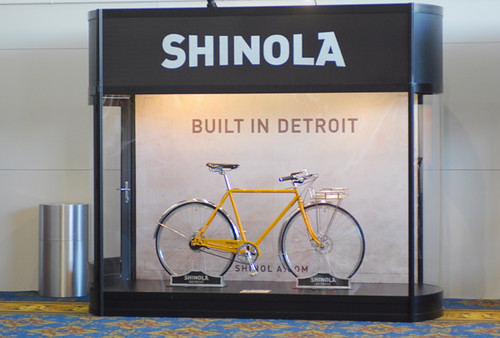
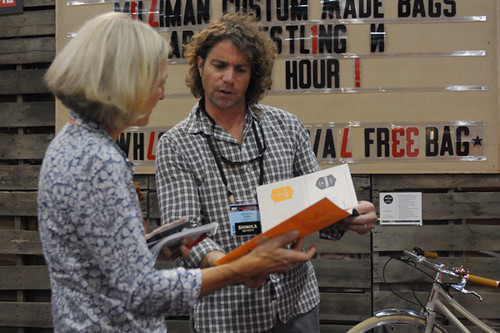
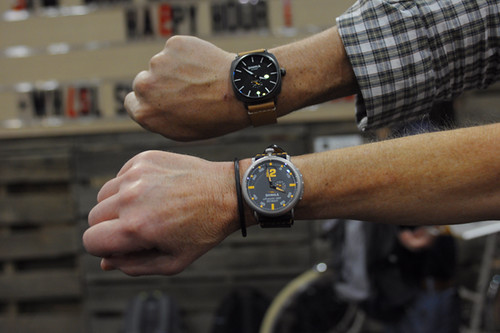


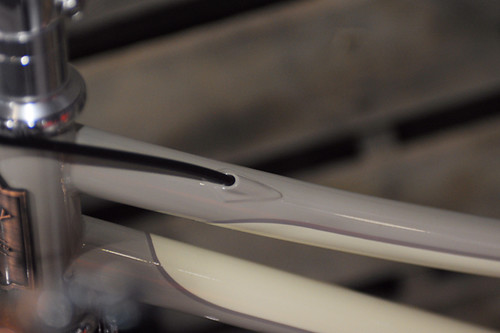
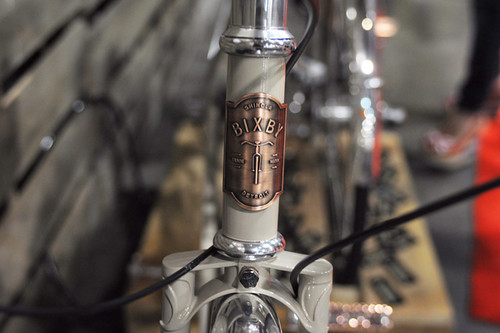

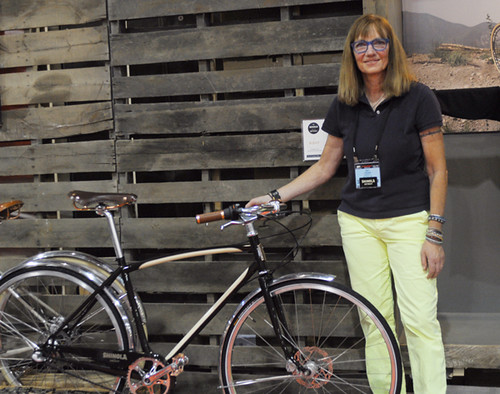
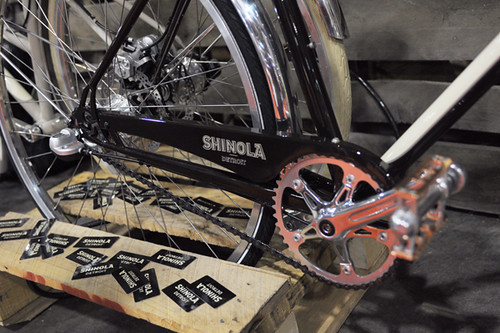

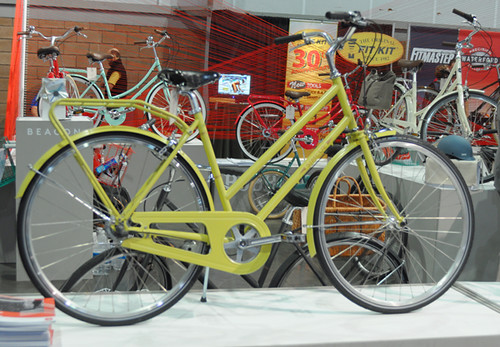
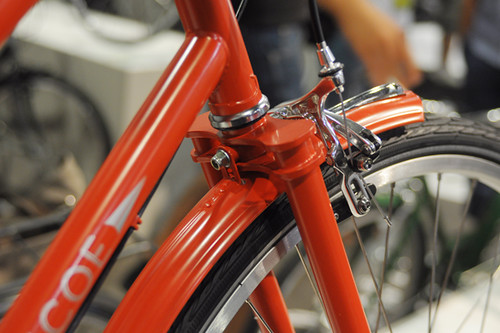



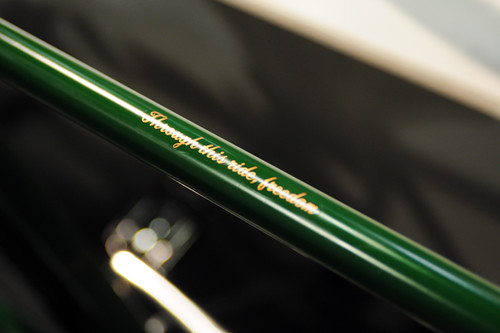
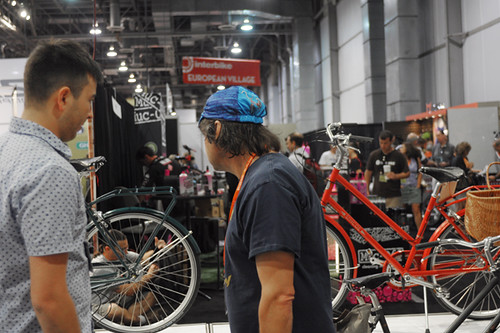

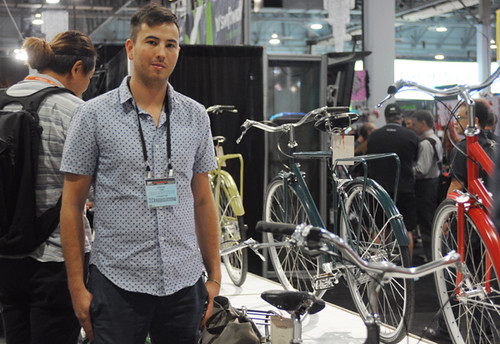
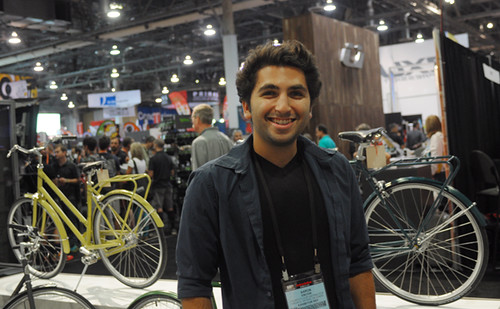
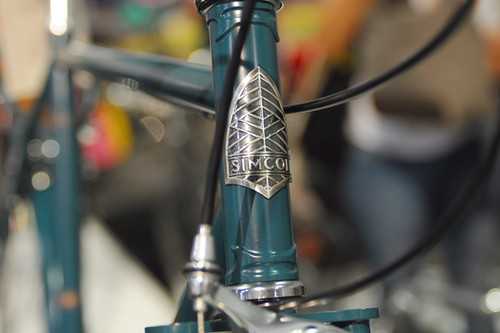
I think the best way for North America to embrace transportation cycling is for gas prices to continue to rise. At that point a critical mass will develop in terms of demand and these new bike companies, hopefully, will be nimble enough to provide light, integrated, bikes capable of more than a jaunt through the park on a beautiful fall day. I worry that now it's still a fashion statement rather than a transportation statement.
ReplyDeleteIf people are only doing something out of necessity, they will only resent it and switch back to the "better" thing as soon as circumstances permit. Establishing bikes as an inherently desirable mode of transport is the more sustainable way to go IMO. That said, yes there is a difference between a short-lived trend and a long-term shift. My hope is that we are seeing the beginnings of the latter.
DeleteAssuming, or asserting, that people will resent something if they are only doing it out of necessity has simply not been the case in my experience. Whether cycling, walking, sewing, or altering many other lifestyle activities because of outside circumstances. During 'brown outs' in California many folks simplified their lifestyle choice and stayed that way. Many start riding bikes because of no longer being able to maintain cars and fall in love with something about it they had not thought of before (i'm speaking of friends here). I've certainly had to cut many things out of my life and adopt alternative methods to thrive and have not looked back. It was a mistake to think the old ways of doing things was 'better' and I wouldn't have known it had I not been forced to change. Everyone's experience it different, of course, and I wish more would simply desire to cycle as transportation and find the infrastructure available.
DeleteThis is just one of those topics that are, well, very subjective and can be spun either way. Funny you mention sewing and walking, since in my experience those in relation to financial/lifestyle assumptions are highly culture-dependent. For example, I've worn hand-sewn clothes since childhood (my mother liked to sew, and I learned when I was young as well), and at different stages of my life and depending on where I lived, this was assumed at times to mean we were poor ("can't afford store-bought clothes?") and at other times that we were rich ("Ah, bespoke tailoring!"). Same clothes, mind you. As for walking, in some European cities (Vienna and Milan for instance) it is a sign of social privilege to say that you walk to work, as it implies you live close to the center.
DeleteBut I suppose like you, in a sense I was forced by circumstance to get a bike several years ago, then thrived as a result and did not look back. Certainly that can happen too.
Yep, having to learn to sew has been a freeing experience. I was embarrassed when I had to get rid of my television -- especially worried about how my kids would feel when friends came over -- but, you know, reading aloud together, playing music and games together, enhanced our lives more than not and even though the kids moaned and griped they now choose not to have one themselves. Other assumptions, like using the dryer, were questioned as well. The kids had to ride/walk places if they wanted to get places and one son, who now lives in Boston btw, still chooses bikes. Sustainability is fun!
DeleteThis comment exemplifies the Green attitude that would have us abandon the conveniences of modern life and return to a way of hardship that our great-grandparents would have dreamed to avoid. Our way of life depends on trustworthy transportation that permits economy of scale in distribution. That insulin that you or your loved one relies upon probably wasn't made in the next town over. If you really want to see this taken to its extreme conclusion, read "One Second After", William R. Forstchen.
DeleteYeah Canada. Yeah Toronto, Ontario. Yeah Simcoe.
ReplyDeleteAs I live directly across the river from Detroit within site of the GM (ugh) towers, Yea Detroit too.
And of course, Yeah transportation bicycling.
Speaking of kids on the block, did you see much in the way of kids bikes? It was difficult finding bikes for my kids post elementary and pre high school which was frustrating.
ReplyDeleteLinus has come out with an adorable line of children's bikes. Nothing else stood out, but then I don't tend to keep an eye out for them.
DeleteHm, why are those Simcoe racks sitting so high? Looks like they used racks for 622 frames on a 559 one.
ReplyDeleteGood point. Hopefully they will resolve that for the production models.
DeleteI read somewhere Waterford is going to make the Shinaola bikes If they indeed will be made in Detroit, that would be special. I have a custom city bke already, but would have to think about getting one to support a good endeavor.
ReplyDeleteBelieve the prototypes were made by Ahearne and Ira Ryan.
Waterford? That's interesting and makes me wonder about the price point. I heard some figures cited, but not sure whether it's public info yet, so did not post them here. However, I'd be surprised if they are able to hit those prices with Waterford as the builder and the components I saw on the display bikes.
DeleteThis a credible source for the Waterford claim. Prices cited there will be 2500 for a three speed, 3500 for a 11 speed model. Good luck with that :-P
DeleteInteresting, thanks for the link. The yellow and the step-through bikes shown in the article photos are not the same bicycles that were brought to Interbike, despite the colour scheme similarities. And the bikes I saw were not lugged (as described in the article). I am guessing they are still not 100% finished prototyping at this stage. Looking forward to seeing where this goes.
DeleteWaterford has the capability to build to a price. They fabricate a wide variety of bikes.
Delete"They love bicycles, all kinds of bicycles, and they communicate a sense of commitment to being in the industry for the long haul."
ReplyDeleteThat's very funny.
The Shinola website ad copy is basically, "steel is real", under prototypes. Yeah, that's a discerning way to separate.
These faux porteurs and swan bikes make me ill. Every manufacturer from Giant to Schwinn to Walmart have these out.
The porteur rack is way too far out over the axle and must handle like shiite with a six pack. The rear rack on the Simcoe shoots their cred in the foot. Meanwhile at these purported price points (anything more than a Schwinn) load carrying obviously wasn't studied or considered. Sigh.
These are indeed trinket bikes or more accurately one is a jewelry hanger and the other nearly a useful bike.
So far none of the big players or the small ones have stepped up to the plate to design elegant stuff-hauling machines. Until they do these all fall under the category of "semi-useful", much less so in fact than an 80s era mtb with a big Wald and Blackburn rack.
If you're going to "handmake something in Dee-troit" weld the bleeding rear rack to the frame for gawd's sake.
The new players are for the kids who want the new thing even though it's a very old thing but done poorly? Same ole same ole.
It's pretty hard to tell the Shinola's trail from a photo. The rack is a prototype. If the finished bikes have the right geometry, get a better rack and you can have something like this:
Deletehttp://www.bikequarterly.com/images/GBwhitetires.jpg
The bike with the rear rack is not claimed to be made in Detroit. Rather, as V says, it is a Taiwan built bike sourced through a Canadian company.
ubrayj02* wrote:
Delete"...
The rack on the Simcoe is a prototype, like most of the bikes shown at Interbike, rushed from the factory. I stopped by this booth, and the guys from 4th Floor said that they are definitely going to make tweaks to the specs. The rear rack will be lower.
Shinola, just from the specs and the story, is going to be a premium low volume bike brand. Perhaps they will make some lower end bikes to sell to non-rich people, but they are finely made bikes.
The benefits and drawbacks of mounting a front cargo anything are well known in the business. Some customers like the sacrifice in steering for the convenience and looks of a front rack/basket.
Big players stepping up to the plate? ...Specialized has for years flogged this category with the beautiful Globe line of bikes. Much to their dismay, and despite their market research, dealers have been slow to accept these types of bikes onto their showroom floors.
What these bike represent is North Americans trying to crack the North American transportation bike market open with North American designs for North American problems. In years past, we've tried Dutch designs, Italian designs, etc.
In the final analysis I think it is natives building bikes for our own geography and needs supported by local government investments in bike infrastructure that is going to push this whole bikes-as-transport thing forward. Welded on rear racks, I think, not so much!"
* Please note that I removed your original comment, because it violates the moderating guidelines. Please review them here. I quoted this bit however, because this is an interesting discussion and I want to respond.
Right, Shinola is the Detroit company; Simcoe is based in Toronto.
DeleteRe the Simcoe racks... Having worked in the role of a designer/consultant with manufacturers (not just bikes, but including bikes), I know that it is not always possible to control how these things come out no matter how precisely you spec them. Stuff just happens in production. This is tough, but at the same time... everyone takes pictures at Interbike and it's an unfortunate fact that things like this will affect how the product is perceived. Simcoe will get negative reactions in response to these racks and will not always be there to explain what happened.
With Shinola, I get the sense that perhaps they are still at the stage of conceptual development at this point, so I will withold judgment until I see a bike they declare as finished. Sky Yaeger is a stellar designer by all accounts, and I am curious to see where this project goes.
I got all in a tizzy about the injustice of it all and mispoke. The offending rear rack isn't made in Detroit I guess, even tho made in Deet means protoed in pdx. I'm so confused. Taiwan made or not, maybe one that fits for the biggest trade show might be appropriate.
DeleteTrail is irrelevant when the porteur rack is mounted needlessly far out. Weight btwn the axles, yep.
Drawbacks of mounting front racks known in the biz? I dunno the author of this blog hated front racks with weight in them until she got a FRAME MOUNTED big bag Brompton. Ahem indicator species. Yeah I'd been harping on about it forever but no one listens to me.
Globes are horrible for carrying front loads -- I've ridden a few. They clearly haven't done their homework on fork/front end geo wrt that end.
Natives building bikes for natives, yep. Globes line has a problem -- people don't want to carry stuff on their bikes, plus they're ALUMINUM and have a harsh ride quality. Very unpleasant compared to pretty much any modern steel bike.
Welded rear rack to frame is a no go? I'm confused. More solid connection, stronger rack, more rigidity is always the goal. Many complaints about the inability of bikes to haul things is due to either inferior design or rider ability. Design it right and people will come knocking, I think.
Until then one can slap a flexy Wald or less flexy CETMA or a flexy VO porteur rack and make do, but like I said start frame-mounting racks and do some research about how loads are carried most stably is key to good design.
I don't know what you're going on about infra as it has nothing to do with a good rack.
As for hassles w/Euro imports I'd be inclined to ring up Todd to put in an order for a Workcycles GR8 if Henry dialed in some cromo but we aren't talking about useful bikes here, just horizontal tt bikes taking their styling cues from overseas.
Here's a crazy thought: make a racery fast bike with a frame mounted quick release rack with neutral handling and I'll be impressed.
Likewise I am impressed with what Tern is doing for design and innovation, tho I need to test ride a bike for ride quality.
I wonder if my wife will mind if I attach a frame mounted Steco front to her Ruby...
BTW my Brompton comment is appropriate since it's a company of ENGINEERS and not DESIGNERS, aye there's the rub.
Sky's bike looks ok the bend on the lower fork looks cool. Not a fan of the Civia paint patterns on the Shinola tho.
I remember when IF displayed last year at NAHBS their "porteur". Gawdawful off the shelf Pass and Stow on they're non-front loader specific geo, also mounted way too far front to keep it level. I hate level front racks.
One more thing I dislike is the "universal attachment" clasps on the panniers. Wow, metal on metal should have a nice ring to it.
Ok, done for now.
http://cycloculture.blogspot.com/2008/07/sky-yaeger-on-integrated-design-and.html
DeleteThis is also funny. The talk of integrated design but no racks at the show. Speaks to welded constructeur-ism but is about accessories, which are necessary of course.
I've ridden a couple of Swobos and they're good bikes with proper geo.
As I said the trick is integrating racks. Let's see if you can do it Sky.
edit: the Pass and Stow is a good rack. What I meant is an off the shelf rack slapped onto an IF is just a bad ideer.
ReplyDeleteI love the Shinola fork crown!
ReplyDeleteActually, Shinola is not the first company to make other products before it started making bicycles. When Cannondale started in 1970, it made the Bugger, one of the first bicycle trailers, as well as bike bags, backpacks and camping and hiking equipment. It didn't start making bicycles until it had been in business for over a decade. Ironically, it has long since stopped making non-cycling outdoor equipment.
Also, Peugeot manufactured tools, machinery and, yes, their famous pepper grinders long before they started to fabricate velocipedes in the 1880's. Miyata made rifles and guns before it started building bicycles, and, of course, Panasonic made radios and other electronics before it started to produce bikes.
I would say that all of them have been taken seriously as bike-makers.
Good point; I think Panasonic is a particularly poignant example. Did not know about Cannondale's pre-bike past.
DeleteIn 1973-74, and again in 1979, gas prices rose to levels that had never before been seen in the US (though they were still a fraction of European or Japanese prices). A few people took up bike commuting, and a few more started to ride recreationally. However, once prices stabilized or dropped, most of those people stopped riding--or, in the case of commuters, became recreational or sport riders. That is an example of a trend.
ReplyDeleteIf gas prices continue to rise, or if there are other changes, we may see the long-term shift Velouria mentions in one of her comments. Whether or not such changes occur, I hope we see such a shift: Seeing more people on bikes, and fewer cars on the road, will definitely improve the quality of life, not to mention the health of this planet.
V wrote: "The slate gray step-through is probably my favourite." unde a picture. That picture and the picture under also is showing a beautiful pannier/bag. Could you tell us more and or link to it?
ReplyDeleteThank you for visiting and writing! Looking forward to more bling.
badmother
There is no info about it yet, except that it's under development. If they send me a bike to review, I'll also ask for the bag.
DeleteNot to steal Simcoe's thunder, but the bag is a Beacon prototype. I's say you can expect a bag once we nail down the final design.
DeleteAh, thanks. I'll note that in the post.
DeleteMmmmm... Now they have my attention. Beautiful bikes! But how much?
ReplyDeleteWith any new activity, people try it and most don't stick with it in the long run. That is normal, and it applies to gym memberships, board games and even reading. However, every time there is a spike in cycling activity, many who are introduced to cycling find they like it and stay with it.
ReplyDeleteThe post-war cycling boom in Paris appears to have been fueled in part by the privations of the German occupation. During the war, people roamed the countryside on bikes in search for farmers who had food to barter against black-market goods from the city. Even though cycling was associated with the darkest hours, quite a few riders found that they really enjoyed cycling, and they kept it up after the war.
I don't understand: there are lovely transportation bikes being built overseas and imported here for less than the ones made by Shinola are supposed to be going to cost. Far less. So why bother? It's not like every dealer on the block is selling out of Bobbins and they're being ridden on every trail. Most people here still buy crappy Walmart faux-mountain bikes. If Bobbin and others are just breaking into the market at half that price point, or less, why would there be a market for bikes that cost twice as much? That said, they do look lovely. But lovely enough to pay custom-bike prices? I don't think so.
ReplyDeleteIf you're going to make a bike in the US, you've got to be able to produce something that's either super special and worth the bazillion dollars that it will cost, or you have to produce something cheap enough to sell to lots of people. I don't see how you can produce very few of something that's not all that special and expect them to sell.
FWIW, I would love to see Bobbins near me. Saw a few in England, and they were lovely bikes. Right now I would have to drive three hours either North or South to test drive one. Does this really indicate a market that's ready for multiple manufacturers? And much higher prices?
As I understand it, the Shinola bikes are meant to support domestic manufacturing and to appeal to those who appreciate this enough to pay a premium. In that context they make sense to me. What makes less sense is that, as you suggest, they don't look all that special - at least not to someone who is used to looking at nice, handmade bikes. So in the end I am not sure how feasible it will be to sell those particular bikes at that price point; but we will see.
DeleteThat's exactly my point: if you're going to charge an arm-and-a-leg for it, it better be super-duper nice and contain lots of hyphens! Clearly, those bikes do not. But seriously, I don't mind paying a bit extra to have something made here. But about a thousand extra? Not so much. Especially when I could, for about that same amount, get a custom bike made just for me by a great local frame maker in any color and style I want. Assuming the prices quoted above are reasonably accurate, anyway. I'd be soooo all over a custom bike at the price point.
DeleteThat bixby is a gorgeous bike. And there's something thrilling about seeing the "Made in Detroit" sign. I hope these guys pull this off. I know that there are economic realities that will have to be overcome somehow, but if American Apparel can doit with clothing, can't someone do it with bikes?
ReplyDelete